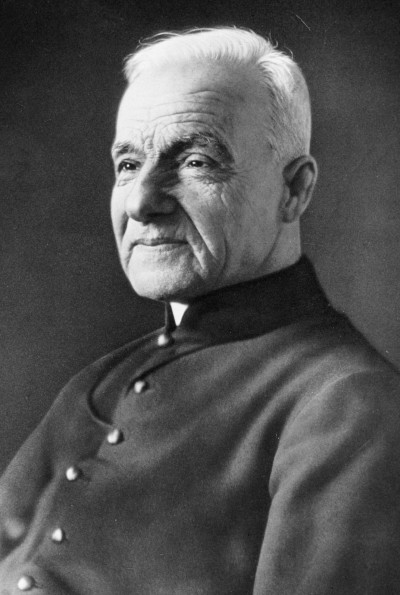Saint André Bessette (André Bessette)

He was born Alfred Bessette in Mont-Saint-Grégoire, Quebec, a small town situated 40 kilometres (25 mi) southeast of Montreal. Bessette was the eighth of 12 children (four of whom died in infancy). He was so frail when he was born that the curé baptized him “conditionally” the following day, completing an emergency ritual performed at his birth. He was from a working-class family; his father, Isaac Bessette, was a carpenter and lumberman, and his mother, Clothilde Foisy Bessette, saw to the education of her children. In 1849, with employment scarce and his family living in poverty, Alfred’s father decided to move to Farnham (in Quebec) where he hoped to earn a living as a lumberman. Tragically, he lost his life in an accident, crushed by a falling tree, when Alfred was only nine years old. His mother found herself widowed at the age of forty with ten children in her care. She died of tuberculosis within three years, and Alfred found himself orphaned at the age of twelve.
The pastor of his parish, the Rev. André Provençal, noticed the devotion and generosity of the young man. He decided to present Alfred to the Congregation of Holy Cross in Montreal, writing a note to the superior, “I’m sending you a saint.” Although he was initially rejected by the order because of frail health, Archbishop Ignace Bourget of Montreal intervened on his behalf, and in 1872, Alfred was accepted, and entered the novitiate of the congregation, receiving the religious name of Brother André, by which he was known for the rest of his life. He made his final vows on February 2, 1874, at the age of 28. André was given the task of porter at Notre Dame College in Côte-des-Neiges, Quebec, with additional duties as sacristan, laundry worker and messenger. “When I joined this community, the superiors showed me the door, and I remained 40 years,” he said.
His great confidence in Saint Joseph inspired him to recommend this saint’s devotion to all those who were afflicted in various ways. On his many visits to the sick in their homes, he would rub the sick person lightly with oil taken from a lamp burning in the college chapel and recommend them in prayer to St. Joseph. People claimed that they had been cured through the prayers of the good Brother and Saint Joseph, and they were grateful their prayers had been heard. Brother André steadfastly refused to take any credit for these cures. Because he wanted St. Joseph to be honored, in 1904 Bessette began the campaign to erect a chapel to honor the saint. When an epidemic broke out at a nearby college, André volunteered to nurse. Not one person died. The trickle of sick people to his door became a flood. His superiors were uneasy; diocesan authorities were suspicious; doctors called him a quack. “I do not cure,” he said again and again. “St. Joseph cures.” In the end he needed four secretaries to handle the 80,000 letters he received each year.
As tensions increased at the College with so many of the sick coming to see the porter, the school officials decided that Brother André could no longer continue with his ministry. He was permitted to receive the sick in the nearby tramway station rather than the College. As his reputation spread, Brother André became quite a controversial figure. There were many religious in the Congregation of Holy Cross, teachers and parents of students at the College who supported him but many others opposed him and even considered him dangerous to the well-being of the school’s reputation because they regarded him as a charlatan. Others were concerned for the good health of the children, fearing the possibility of contagion in the school spread from diseases carried by the sick who frequented Brother André. In 1924 construction of a basilica named Saint Joseph’s Oratory began on the side of the mountain, near Bessette’s chapel.
Bessette died in 1937, at the age of 91. A million people filed past his coffin. The remains of Bessette lie in the church he helped build. His body lies in a tomb built below the Oratory’s Main Chapel, except for his heart, which is preserved in a reliquary in the same Oratory. The heart was stolen in March 1973, but was recovered in December 1974 with the help of famous criminal attorney, Frank Shoofey . Brother André was beatified by Pope John Paul II on May 23, 1982. The miracle cited in support of his beatification was the healing in 1958 of Giuseppe Carlo Audino, who suffered from cancer. St. Andre is commemorated in most of the world by an optional memorial on January 6. His memorial is celebrated in Canada on January 7. On December 19, 2009, Pope Benedict XVI promulgated a decree recognizing a second miracle at Blessed André’s intercession. and on October 17, 2010, Pope Benedict XVI formally declared sainthood for him.
Born
- August, 09, 1845
- Canada
- Mont-Saint-Grégoire, Quebec
Died
- January, 06, 1937
- Canada
- Montreal, Quebec



